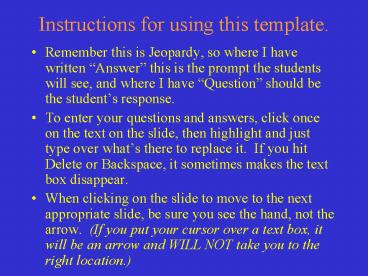Instructions for using this template. - PowerPoint PPT Presentation
1 / 56
Title:
Instructions for using this template.
Description:
Instructions for using this template. ... To enter your questions and answers, ... Three ways to get your money's worth from school. Go to class. Work hard ... – PowerPoint PPT presentation
Number of Views:83
Avg rating:3.0/5.0
Title: Instructions for using this template.
1
Instructions for using this template.
- Remember this is Jeopardy, so where I have
written Answer this is the prompt the students
will see, and where I have Question should be
the students response. - To enter your questions and answers, click once
on the text on the slide, then highlight and just
type over whats there to replace it. If you hit
Delete or Backspace, it sometimes makes the text
box disappear. - When clicking on the slide to move to the next
appropriate slide, be sure you see the hand, not
the arrow. (If you put your cursor over a text
box, it will be an arrow and WILL NOT take you to
the right location.)
2
Jeopardy
Choose a category. You will be given the
answer. You must give the correct question.
Click to begin.
3
Choose a point value.
Choose a point value.
Click here for Final Jeopardy
4
Successful students
Goal setting
Time Management
Learning styles
Underlining textbooks
10 Points
10 Points
10 Points
10 Points
10 Points
20 Points
20 Points
20 Points
20 Points
20 Points
30 Points
30 Points
30 Points
30 Points
30 Points
40 Points
40 Points
40 Points
40 Points
40 Points
50 Points
50 Points
50 Points
50 Points
50 Points
5
SQ5R is an example of one
6
A textbook study system
7
The problem that most students have who already
underline
8
Underlining too much
9
Five things you look at during the preview step
10
Chapter title Introduction Headings and
subheadings Visual materials Summary
11
How you do the question step
12
Set a purpose for your reading by asking
questions from the headings and subheadings
13
The difference between the question step and
writing questions in the margin
14
Questions in the question step are just in your
mind, and their purpose is to help you pay
attention to what you read. Writing questions in
the margin is part of the record step.
15
The three components of Weinsteins model of
strategic learning
16
Skill Will Self-regulation
17
The three factors that influence motivation
18
Goals Self-efficacy Level of effort
19
Three ways to get your moneys worth from school
20
Go to class Work hard Keep up-to-date with
assignments
21
Three methods of coping with stress
22
Take action Seek social support Balance work and
relaxation
23
The definition of self-efficacy
24
The belief in your ability to successfully
complete a task
25
Three learning modalities
26
Visual Auditory Kinesthetic
27
These learners tend to better understand a
professors lecture when they read the text
material ahead of time
28
Visual learners
29
Many of the strategies used by the other two
kinds of learners also appeal to these learners
30
Kinesthetic
31
What research says about the benefits of studying
by only using your preferred learning style
32
There is no benefit to only using your preferred
learning style
33
This researcher developed the theory of multiple
intelligences
34
Howard Gardner
35
Goals can be classified in several ways
36
Long and short-term Academic and personal Outcome
and process
37
Six characteristics of useful and motivating goals
38
Self-chosen Moderately challenging Realistic Measu
rable Specific Positive
39
The five steps of writing effective goal
statements
40
Tentative statement Obstacles Resources Revised
statement Polished statement
41
Three characteristics of an affirmation statement
42
Short Positive Present-tense
43
According to Locke and Latham, goal setting
improves performance in four ways
44
Goals direct our attention to the task at
hand Goals mobilize effort Goals increase
persistence Goals promote the development of new
strategies
45
The first rule of good time management
46
Dont let time manage you you must learn,
instead, to manage time
47
The first step in better time management
48
Evaluate how you actually use time now
49
Six considerations when you estimate how much
time you need to study
50
Your credit load The difficulty of your
classes Your goals How long it takes to do your
assignments Long-term assignments Monitor your
current study time
51
Three main causes of procrastination
52
Self-downing Low frustration tolerance Hostility
53
Six time-management strategies to stay motivated
54
Study in one-hour blocks Take breaks Tackle
difficult assignments first Switch subjects Bread
tasks down Plan rewards
55
Final Jeopardy
Make your wager
56
The oldest and best known textbook study system
57
SQ3R































